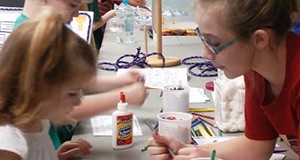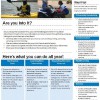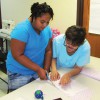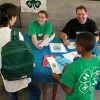A successful county Shooting Sports program is not possible without screened and trained volunteers to lead clubs. Before instructing youth in any Shooting Sports discipline and/or assisting on the range, a volunteer must meet the Florida 4-H youth protection screening requirements and complete the Florida 4-H Shooting Sports Level 1 Instructor Training. This 3-page fact sheet discusses volunteer recruitment, training, certification in other Shooting Sports disciplines, Level 2 certification, and job duties. Written by Julie P. Dillard, Heather C. Kent, and Julia S. Kelly, and published by the UF/IFAS 4-H Youth Development Department, January 2018.
http://edis.ifas.ufl.edu/4h382
Tag: 4-H Volunteer Training Series
Volunteer Training Series: 4-H Cloverbuds Program: 4-H for Younger Members
 Florida 4-H programs offered to children ages 5 to 7 are called 4-H Cloverbud programs and are a component of the Florida 4-H Youth Development Program. The goal of the Florida 4-H Cloverbud program is to offer age-appropriate, fun, and exploratory learning experiences for children in the 5 to 7 age group. This 5-page fact sheet describes the best management practices 4-H faculty and volunteers should use when teaching and interacting with this age group. Written by Amanda Squitieri and Sarah Hensley, and published by the UF Department of 4-H Youth Development, July 2015.
Florida 4-H programs offered to children ages 5 to 7 are called 4-H Cloverbud programs and are a component of the Florida 4-H Youth Development Program. The goal of the Florida 4-H Cloverbud program is to offer age-appropriate, fun, and exploratory learning experiences for children in the 5 to 7 age group. This 5-page fact sheet describes the best management practices 4-H faculty and volunteers should use when teaching and interacting with this age group. Written by Amanda Squitieri and Sarah Hensley, and published by the UF Department of 4-H Youth Development, July 2015.
http://edis.ifas.ufl.edu/4h369
Running a Smooth 4-H Business Meeting
 A quality 4-H club meeting consists of three main parts: (1) the business meeting, (2) an educational component, and (3) a recreational component. This 4-page fact sheet focuses on running a smooth 4-H business meeting. Written by Chris DeCubellis, and published by the UF Department of 4-H Youth Development, July 2014.
A quality 4-H club meeting consists of three main parts: (1) the business meeting, (2) an educational component, and (3) a recreational component. This 4-page fact sheet focuses on running a smooth 4-H business meeting. Written by Chris DeCubellis, and published by the UF Department of 4-H Youth Development, July 2014.
http://edis.ifas.ufl.edu/4h344
4-H Project Learning
 A project is a planned series of learning experiences of six hours or more within a particular area of youth interest (Florida 4-H definition). The purpose of a 4-H project is to promote mastery of subject matter and to foster life skill development. This 4-page fact sheet was written by Judith Levings, and published by the UF Department of 4-H Youth Development, August 2014.
A project is a planned series of learning experiences of six hours or more within a particular area of youth interest (Florida 4-H definition). The purpose of a 4-H project is to promote mastery of subject matter and to foster life skill development. This 4-page fact sheet was written by Judith Levings, and published by the UF Department of 4-H Youth Development, August 2014.
http://edis.ifas.ufl.edu/4h343
Protecting Youth and Volunteers by Planning Ahead, Reducing Risk
 The UF/IFAS Extension 4-H Youth Development Program is committed to the safety and well-being of its youth as well as the volunteers who help deliver 4-H programs under the supervision of 4-H faculty and staff. All things in life involve some sort of risk. This is especially true when working with youth, but there are many ways that volunteers can minimize this risk and lead safe 4-H activities. Proper planning and common sense certainly go a long way. Although not to be considered legal advice, here are some facts and issues to know and keep in mind while serving as a 4-H volunteer. This 3-page fact sheet was written by Keith G. Diem, and published by the UF Department of 4-H Youth Development, July 2014.
The UF/IFAS Extension 4-H Youth Development Program is committed to the safety and well-being of its youth as well as the volunteers who help deliver 4-H programs under the supervision of 4-H faculty and staff. All things in life involve some sort of risk. This is especially true when working with youth, but there are many ways that volunteers can minimize this risk and lead safe 4-H activities. Proper planning and common sense certainly go a long way. Although not to be considered legal advice, here are some facts and issues to know and keep in mind while serving as a 4-H volunteer. This 3-page fact sheet was written by Keith G. Diem, and published by the UF Department of 4-H Youth Development, July 2014.
http://edis.ifas.ufl.edu/4h342
Positive Discipline for Youth
 Working with youth, especially other people’s, can be a challenge. While some are better behaved than others, they all need acceptance and the opportunity to learn. Especially in groups of mixed ages, experience, or interests, the challenge of a youth leader is to see that disruptive youth do not prevent others from learning or having fun. Their very presence in the group, combined with your wise guidance, will help them learn what is socially acceptable and how to do what is right. This information sheet will help you to understand youth better and to provide some ideas on how to deal with the unruly kids with minimal disruption of the learning situation. This 5-page fact sheet was written by Heidi L. Radunovich, Keith G. Diem, and Georgene Bender, and published by the UF Department of 4-H Youth Development, July 2014.
Working with youth, especially other people’s, can be a challenge. While some are better behaved than others, they all need acceptance and the opportunity to learn. Especially in groups of mixed ages, experience, or interests, the challenge of a youth leader is to see that disruptive youth do not prevent others from learning or having fun. Their very presence in the group, combined with your wise guidance, will help them learn what is socially acceptable and how to do what is right. This information sheet will help you to understand youth better and to provide some ideas on how to deal with the unruly kids with minimal disruption of the learning situation. This 5-page fact sheet was written by Heidi L. Radunovich, Keith G. Diem, and Georgene Bender, and published by the UF Department of 4-H Youth Development, July 2014.
http://edis.ifas.ufl.edu/4h341
Making Learning Fun
 As a 4-H volunteer, one of your most important roles is helping youth learn. Especially because membership in 4-H is voluntary, learning in 4-H must be fun. Even if you’re not a teacher by profession, you can successfully guide youth to learn communication, leadership, citizenship, and other life skills, as well as subject matter through their 4-H projects and club participation. This 5-page fact sheet was written by Keith G. Diem and Judy Levings, and published by the UF Department of 4-H Youth Development, July 2014.
As a 4-H volunteer, one of your most important roles is helping youth learn. Especially because membership in 4-H is voluntary, learning in 4-H must be fun. Even if you’re not a teacher by profession, you can successfully guide youth to learn communication, leadership, citizenship, and other life skills, as well as subject matter through their 4-H projects and club participation. This 5-page fact sheet was written by Keith G. Diem and Judy Levings, and published by the UF Department of 4-H Youth Development, July 2014.
http://edis.ifas.ufl.edu/4h340
Planning a Successful Field Trip
 Field trips can be great experiences for youth to learn project content and life skills. Field trips also contribute to the experiential learning philosophy of 4-H. This document includes some suggestions to make a field trip fun, safe, and educational. This 3-page fact sheet was written by Keith G. Diem and Ben Knowles, and published by the UF Department of 4-H Youth Development, July 2014.
Field trips can be great experiences for youth to learn project content and life skills. Field trips also contribute to the experiential learning philosophy of 4-H. This document includes some suggestions to make a field trip fun, safe, and educational. This 3-page fact sheet was written by Keith G. Diem and Ben Knowles, and published by the UF Department of 4-H Youth Development, July 2014.
http://edis.ifas.ufl.edu/4h339
Adopting 4-H Club Bylaws
 Why does a 4-H club (for youth ages 8–18) need bylaws? For the same reason our country needs a constitution! By having fair and written rules, the rights of all members can be protected. The following is a suggested format for 4-H bylaws. The bylaws below may be adapted to meet local conditions. Be sure to send a copy of your club’s approved bylaws to your county 4-H office. Include in the bylaws the date when they were approved and most recently revised.This 3-page fact sheet was written by Keith G. Diem, Judy Levings, and Ben Knowles, and published by the UF Department of 4-H Youth Development, July 2014.
Why does a 4-H club (for youth ages 8–18) need bylaws? For the same reason our country needs a constitution! By having fair and written rules, the rights of all members can be protected. The following is a suggested format for 4-H bylaws. The bylaws below may be adapted to meet local conditions. Be sure to send a copy of your club’s approved bylaws to your county 4-H office. Include in the bylaws the date when they were approved and most recently revised.This 3-page fact sheet was written by Keith G. Diem, Judy Levings, and Ben Knowles, and published by the UF Department of 4-H Youth Development, July 2014.
http://edis.ifas.ufl.edu/4h338
The ABCs of 4-H: A Primer for 4-H Volunteers
 This information sheet is the introduction to the 4-H Volunteer Training Series (VTS). The series contains a wealth of information, from how to start a club, to planning field trips, to how to work with youth. This 5-page fact sheet was written by Keith G. Diem and Ben Knowles, and published by the UF Department of 4-H Youth Development, July 2014.
This information sheet is the introduction to the 4-H Volunteer Training Series (VTS). The series contains a wealth of information, from how to start a club, to planning field trips, to how to work with youth. This 5-page fact sheet was written by Keith G. Diem and Ben Knowles, and published by the UF Department of 4-H Youth Development, July 2014.
http://edis.ifas.ufl.edu/4h335
Selecting a Name for Your 4-H Club
 Each 4-H club is a unique group of individuals who work together toward common goals. A club name should reflect the purpose(s) of the club, often relating to the project(s) the club participates in, or the geographic area where members live or the club meets. One of the first ways to develop a sense of belonging and youth engagement is allowing all of the members to participate in selecting a name for the club. Information in this sheet may help you guide the members in making a wise name choice. This 2-page fact sheet was written by Keith G. Diem, Marilyn N. Norman, Joy C. Jordan, and Lindsey McConnell, and published by the UF Department of 4-H Youth Development, July 2014.
Each 4-H club is a unique group of individuals who work together toward common goals. A club name should reflect the purpose(s) of the club, often relating to the project(s) the club participates in, or the geographic area where members live or the club meets. One of the first ways to develop a sense of belonging and youth engagement is allowing all of the members to participate in selecting a name for the club. Information in this sheet may help you guide the members in making a wise name choice. This 2-page fact sheet was written by Keith G. Diem, Marilyn N. Norman, Joy C. Jordan, and Lindsey McConnell, and published by the UF Department of 4-H Youth Development, July 2014.
http://edis.ifas.ufl.edu/4h337
How to Start a Club (for Youth Ages 8–18)
 Being in a 4-H club provides important opportunities for youth to learn subject matter and life skills while working with a caring adult and other youth. Once youth are 4-H members, they become eligible for a variety of the benefits of belonging to 4-H, including awards, trips, and special events. Of course, it’s meant to be fun for the kids and the leaders too! Starting a 4-H club isn’t difficult, and you are encouraged to seek help from parents or other volunteers. Local Extension/4-H staff can help you get started. This 4-page fact sheet was written by Keith G. Diem, Joy Jordan, Bryan Terry, Dale Pracht, Judy Butterfield, Adam Cletzer, Lindsey McConnell, and Ben Knowles, and published by the UF Department of 4-H Youth Development, July 2014.
Being in a 4-H club provides important opportunities for youth to learn subject matter and life skills while working with a caring adult and other youth. Once youth are 4-H members, they become eligible for a variety of the benefits of belonging to 4-H, including awards, trips, and special events. Of course, it’s meant to be fun for the kids and the leaders too! Starting a 4-H club isn’t difficult, and you are encouraged to seek help from parents or other volunteers. Local Extension/4-H staff can help you get started. This 4-page fact sheet was written by Keith G. Diem, Joy Jordan, Bryan Terry, Dale Pracht, Judy Butterfield, Adam Cletzer, Lindsey McConnell, and Ben Knowles, and published by the UF Department of 4-H Youth Development, July 2014.
http://edis.ifas.ufl.edu/4h336
